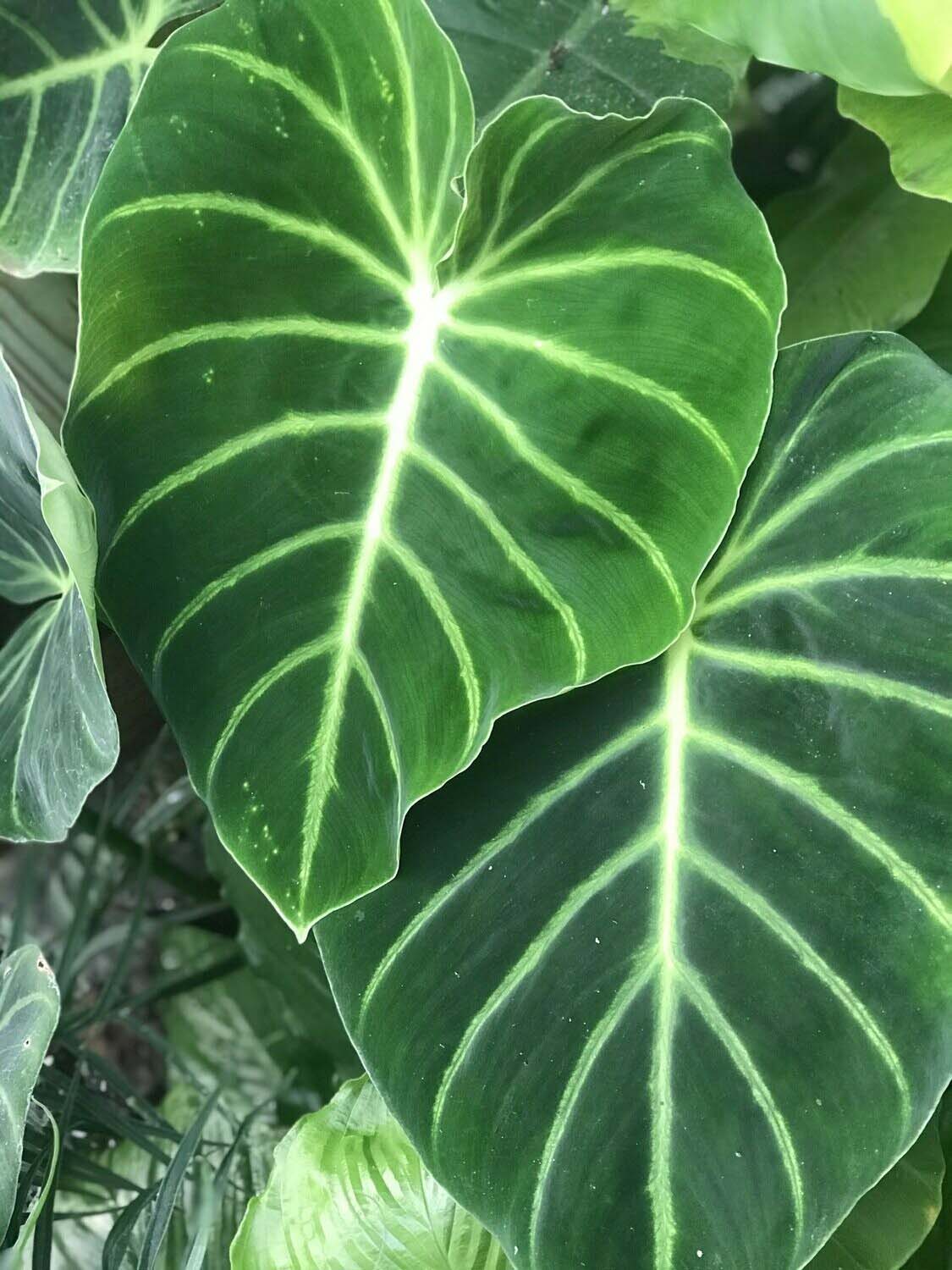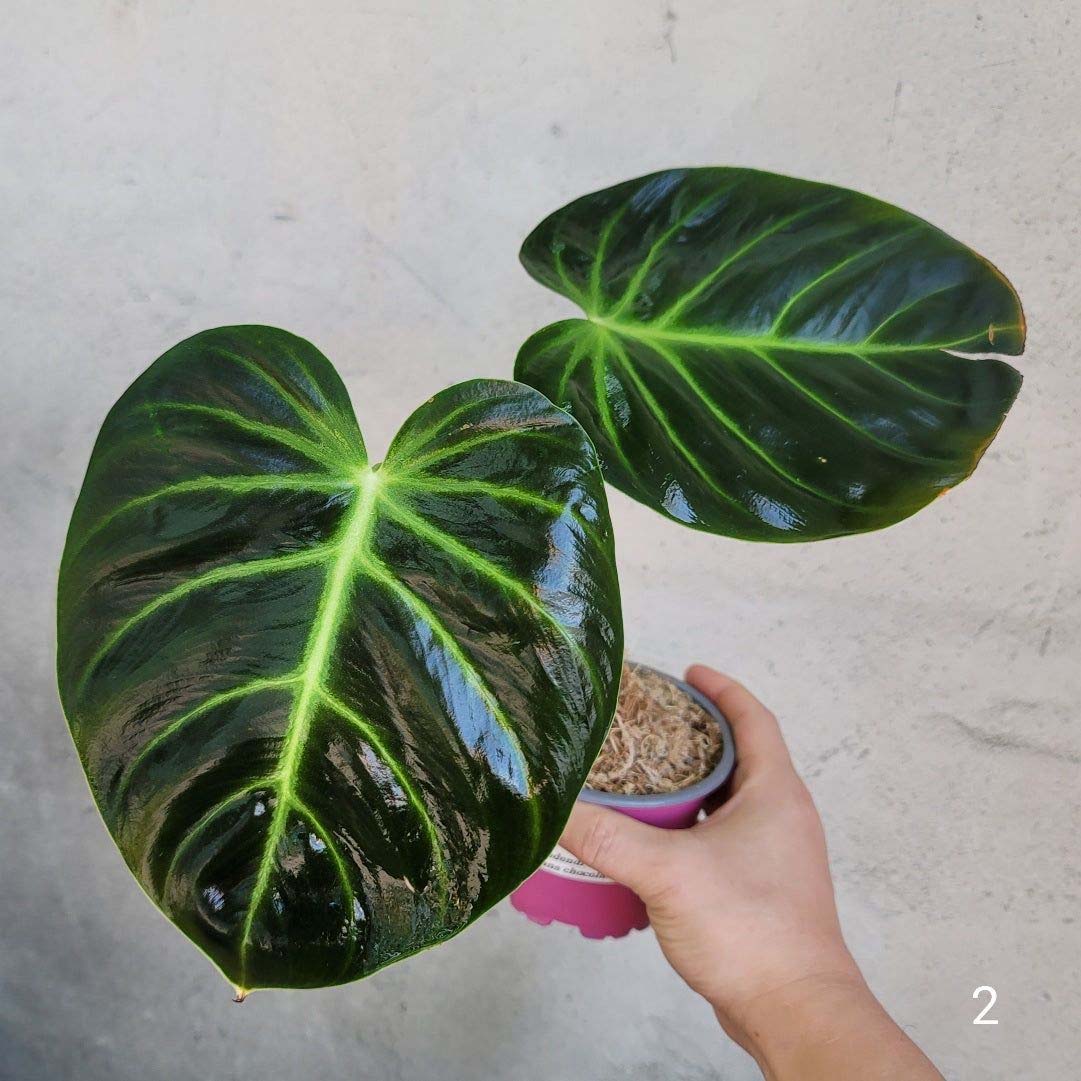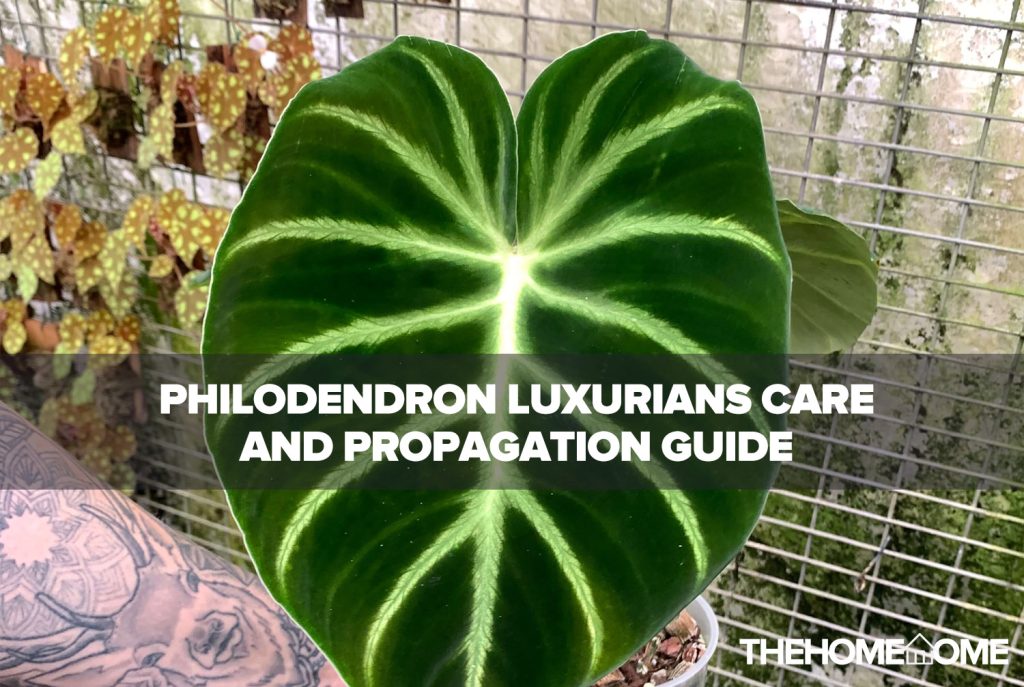The Philodendron Luxurians, with its heart-shaped foliage, is a rare variety that is popular among houseplant growers and interior decorators. Its deep green foliage color is a striking feature that instantly captivates and enhances your living space. When grown in attractive containers, the Philodendron Luxurians is a showstopper.
As a low-maintenance plant, all this plant requires to thrive is proper watering, an appropriate container, adequate lighting, periodic fertilization and pruning, and a pest-free environment.
If the Philodendron Luxurians are next on your propagation list, we have got all you need to know about its propagation, care, growing tips, and common problems associated with growing the Philodendron Luxurians right here.
Your journey to growing a thriving Philodendron Luxurians plant starts from here.
Philodendron Luxurians Plant Profile
This is the plant profile of the Philodendron Luxurians:
| Botanical name | Philodendron Luxurians |
| Origin | Tropical America |
| Family | Araceae |
| Light | Bright indirect light |
| Watering | Moderate watering |
| Temperature | 65°F-80°F |
| Toxicity | Toxic to pets and humans |
| Propagation Style | Indoor and Outdoor propagation |
| Food | Balanced Liquid-Based Fertilizer |
| Humidity | Low humidity |
| Foliage color | Green |
| Susceptible Plant Issues | Root rot, stunted growth, curled tips, wilting leaves, discoloration of foliage surface, cold injury, and Pest Infestations. |
Propagation of Philodendron Luxurians
Philodendron Luxurians can be propagated using three different methods: soil propagation, water propagation, and air layering. Soil propagation is the simplest and most likely successful method for beginners.
While water propagation might be tricky for beginners, it allows growers to see their plants mature fully, unlike other techniques of propagation.
1. Soil Propagation
There are certain items needed for successful soil propagation. These items are Philodendron Luxurians mother plant, organic soil, well-drilled container, scissors, dribble, water, and rooting hormone (optional). These are the steps to follow using soil propagation for your Philodendron Luxurians:
- Step 1: Pour your organic soil into a well-drilled container.
- Step 2: Thoroughly water it until the water drains through it.
- Step 3: Select and cut a healthy stem with at least two nodes. Ensure you cut below the node. The cutting should have at least 2 leaves along the stem.
- Step 4: Apply your rooting hormone to the base of the stem (optional).
- Step 5: Using a dribble, make a hole in your potting mix using a dribble. Then insert your cutting till it is secured and upright.
- Step 6: Mist the plant.
- Step 7: Place the container in an area where it can receive bright indirect light.
Monitor the plant while properly tending to its growth needs till the roots fully develop. Philodendron Luxurians’ roots develop within four weeks of propagation. Once the roots are fully developed, transplant them.

2. Water Propagation
For water propagation, you will need a Philodendron luxurious mother plant, water, a clean glass jar, and scissors. These are the steps to follow using water propagation for your Philodendron Luxurians:
- Step 1: Select and cut a healthy stem with at least 2 nodes. Ensure you cut below the node. Each cutting should have at least 3 leaves along the stem.
- Step 2: Place the cutting in a clean glass jar.
- Step 3: Ensure your Philodendron Luxurians are not submerged in the jar. This could result in root rot and futile propagation.
- Step 4: Situate the plant where it can receive bright indirect light.
- Step 5: Change the water every 3-5 days. The water must never become murky. In addition, never use water below or above room temperature.
Water propagation allows you to watch the growth of your plant. However, this propagation method requires that you devote time and energy till the roots are fully developed and the plant has been successfully transplanted. Your Philodendron Luxurians should start developing roots within 3-4 weeks of propagation.
3. Air layering
Air layering is mostly used for outdoor propagation. These are the items you would need: Philodendron Luxurians mother plant, string or twine, organic soil, water, plastic wrap, small plastic piece or bottle, sphagnum peat moss.
- Step 1: Moisten the peat moss.
- Step 2: Cut through the base of one of the branches.
- Step 3: To keep the cut areas from sealing up, insert a small piece of plastic between them.
- Step 4: Gently wrap the stem with the peat moss till it is fully secure in the peat moss.
- Step 5: Wrap plastic wrap around the moss ball.
- Step 6: Cut the branch from the mother plant once the roots have fully developed.
- Step 7: Remove the plastic wrap but do not remove the moss ball because the roots are tightly connected inside it. Disintegrating the moss ball could lead to plant problems.
- Step 8: Transfer the plant to another container with an organic soil mix.
Philodendron Luxurians Care Guide
Your Philodendron Luxurians would thrive when it is adequately provided with these growth needs:
1. Adequate Watering
The Philodendron Luxurians thrives when it receives adequate watering. For proper growth, the watering needs of your Philodendron Luxurians should never be neglected. Underwatering and overwatering your plant can hinder its proper growth.
Underwatering or overwatering can be avoided by creating a watering schedule that suits the needs of the plant. The plant should be watered at least once every week. Use a moisture gauge to determine the dryness level of the soil before watering. This helps you determine how much water the soil needs.
2. Adequate Light
Your Philodendron Luxurians should be grown in a location where they can receive bright but indirect sunlight. Providing adequate light is essential for your plant’s brilliant foliage color and vigor. Exposure to poor light is the fastest way to destroy the plant.
3. Organic Soil Mix
The Philodendron luxurians thrive when it is grown in organic soil. Beginners can purchase a general potting soil mix for their plants. You can increase the organic matter in your soil mix by adding peat moss, coco coir, or perlite.
Organic soil is the best option because it drains well and does not get waterlogged easily, unlike other soil mixes.
4. Well-drilled Container
A well-drilled container allows good drainage of water and prevents the soil from getting swamped easily. In addition, use a ceramic or plastic container rather than an aluminum one. This is because, over time, chemicals from the aluminum can seep into the soil and affect the growth of the plant.
5. Fertilization
Fertilization is necessary to enhance and sustain the growth of your Philodendron Luxurians. The best time to apply fertilizers is during their active growing season, which is during spring and summer.
Applying fertilizer to the plant should be based on the instructions and directions recommended on the label. Overfertilization should be avoided because it can lead to root problems for the plant.
6. Repotting
Repotting is an essential aspect of the growth of your Philodendron Luxurians. You should repot your Philodendron luxurians periodically because their soil’s nutrients deplete over time. To sustain their growth, providing fresh soil is necessary. Repotting is also important when the plant becomes root-bound. Rootbound plants have stunted growth and a drier potting mix.

7. Pruning
The Philodendron Luxurians is a leafy houseplant, hence, the need to prune periodically. Pruning helps maintain the shape of the plant and gets rid of damaged, diseased, and dead leaves, allowing for faster growth of new leaves.
Philodendron Luxurians Plant Problems, Causes, And How To Fix Them
These are the common plant problems associated with the Philodendron Luxurians:
| Plant problems | Signs | Causes | Solutions |
| Root rot | Stunted growth. Yellowed leaves. Drooping leaves. The appearance of discolored spots on the foliage surface Mushy stems. | Overwatering Overfertilization | Avoid watering the plant till the root recovers. Avoid fertilizing the plant for a while. Repot the plant if necessary. |
| Stunted growth | Leggy plant | Inadequate light Overfertilization Pest infestation Root rot Transplant shock | Place your plant in a location where it can receive bright indirect light. Repot the plant. Combat pest infestation. Avoid applying fertilizer after transplanting. |
| Curled Tips | Leaf tips curl downward | Overfertilization | Apply fertilizers periodically. |
| Pest infestation(Aphids, mealy bugs, scales, and spider mites) | Stunted growth Holes on the foliage surface. Drooping leaves Discoloration | Poor environmental hygiene. Purchasing infested plant. Transmission from infected pruning equipment to plants. | Separate infested plants from healthy ones. Quarantine new plants from others to check for signs of pest diseases and to prevent spread. Use insecticidal sprays or soaps on your plants. Sterilize pruning equipment before use. |
| Bacterial leaf spot | Translucent spot on leaf margins | Overwatering Purchasing a diseased plant | Ensure you purchase a disease-free plant. Avoid overhead watering. Remove infected leaves |
| Cold injury | Green and brown blotches between leaf veins | Exposure to extreme weather conditions | Change the location of plants near air conditioners. |
Preventing Philodendron Luxurians Plant Problems
Before buying a Philodendron luxurians, make sure it’s free of diseases. Look for symptoms of spots, discoloration, and poor vigor in the foliage color and appearance to confirm its health.
Root rot can be prevented by watering your plant frequently and moderately. In addition, apply fertilizer as recommended by the label to prevent overfertilization.
Stunted growth is usually associated with many factors. Ensure your plant is grown in an area where it can receive bright indirect light. Any action that can lead to root rot, such as under and overwatering, and overfertilization, should be avoided. If required, re-pot the plant to give it a fresh start.
Ensure your Philodendron Luxurians are grown in a clean environment. We recommend that you maintain high environmental hygiene, especially when growing the Philodendron Luxurians outdoors. Periodically use insecticidal soaps and sprays on your Philodendron Luxurians plant.
Gradually expose the plant to the new location to decrease the effect of transplant shock when transferring it from indoors to outdoors. You can take the plant outside for two hours every day, then gradually increase the time exposure until it is permanently relocated. During this period, don’t fertilize the plant.
Growing Tips For Philodendron Luxurians
These are growth tips for your Philodendron luxurians:
- Repot the plant once it becomes root-bound.
- Use an appropriately sized container for your Philodendron luxurians.
- Keep your plant away from children and pets.
- Once you notice a change in foliage appearance, identify what you may be doing wrong.
- For Philodendron Luxurians grown outdoors, ensure they are grown in a shaded location to prevent them from exposure to direct sunlight.
- Never expose the plant to extreme weather conditions.
- Sterilize pruning equipment before using them to prevent pest infestation.
Frequently Asked Questions
Is Philodendron luxurians rare?
Yes, Philodendron luxurians are rare. This is why this variety is expensive. Most of the time, growers order the plant and have to pay shipping fees.
Do Philodendron luxurians need to be misted?
Yes, Philodendron luxurians need to be misted. Misting improves the humidity of your plants.
Conclusion
Philodendron Luxurians is a low-maintenance and easy-to-propagate plant, so long as you are familiar with its growth needs and you adequately provide for them.
Successful propagation is guaranteed when the plant is adequately catered for. With the guidelines and tips provided, we assure you of successful propagation.
Similar Plant Care Guides On TheHomeTome:

